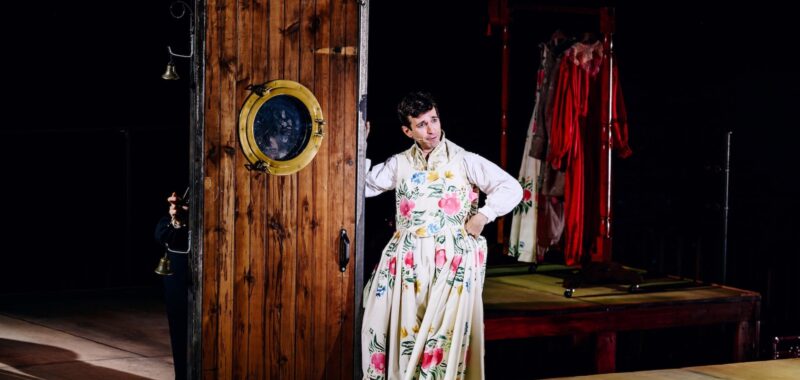NEW YORK — Anthony Roth Costanzo gives a truly inside look at one of Mozart’s most loved operas.
Singing seven different roles in a madcap presentation of “Le Nozze di Figaro (The Marriage of Figaro)” at New York’s Little Island, the countertenor labors through the Countess’ “Dove sono” aria with a steel laryngoscope down his throat while a video recording of his throbbing vocal chords is displayed on screens.
“After the first part of the opera in which I’ve torn my voice to shreds essentially going through all of these hijinks and she has been carried offstage in a stretcher, she comes back in a hospital gown and she has this nightmare of her husband, the Count, giving her a laryngoscopy, which of course has all kinds of sexual innuendo,” Costanzo said.
A 42-year-old Grammy Award winner who is among the world’s top countertenors, Costanzo sang Cherubino for his Opera Santa Barbara debut in 2000. He adds Figaro, Susanna, the Count, Countess, Antonio and Barbarina, stretching his voice 3 1/2 octaves in an invigorating and entertaining 95-minute reinvention of a work that premiered in 1786.
“When was the last time you went to an opera that wasn’t `Tristan’ thinking: Is he going to make it?” said Zack Winokur, Little Island’s producing artistic director.
The 18-performance run, a highlight of Little Island’s first season, started Friday at the 700-seat amphitheater built in Manhattan above the Hudson River and extends through Sept. 22.
“We just really want to tell the story of `The Marriage of Figaro,′ show people who maybe don’t necessarily come to the opera a good time, kind of test the limits of what opera purists will tolerate,” director Dustin Willis said.
Costanzo’s concept developed after “Only an Octave Apart,” his concert performance with Justin Vivian Bond that reopened Brooklyn’s St. Ann’s Warehouse in 2021 following the pandemic closure and then went on tour. Staged by Winokur, the show mixed pop and classical, including “Crudel! Perché finora.” a third-act aria of the Count and Susanna, as a comic number.
“It stopped being a gag and started being just excellent, and I was like: ‘Can you do the rest of this?’” said Winokur, who staged the concert.
Winokur was hired to open Little Island’s first season in June. He had a slot available when a planned staging of Britten’s “Peter Grimes” fell through, and in January, participated in a “Nozze” workshop with Costanzo, Willis, dramaturg Jacob Mallinson Bird and music director Dan Schlosberg.
“It is such divine music and such mad-cap bananas storytelling,” Winokur said. “It’s very funny. It’s incredibly precise physically, and it is a kind of a Olympic task.”
Costanzo sang both Susanna and Figaro as a door kept swinging in the opening “Cinque … dieci … venti.” He took both parts of “Sull’aria,” performing the Countess live while a recording of his Susanna is played, seemingly from a Victrola.
“Singing harmony with myself was very bizarre,” he said. “What does it mean to sing with your own disembodied voice and what are all of the different, interpretations that we could have?”
Trims included Bartolo along with his “La vendetta” aria. Costanzo was backed by an eight-person orchestra that sounded light at times mixed with Costanzo’s amplified voice in the outdoor space.
He was joined by actors who mimed roles alongside him: Daniel Liu (Countess), Ariana Venturi (Count), Christopher Bannow (Figaro) and Emma Ramos (Susanna). They open dressed as a union work crew and wind up donning costumes to accomplish needed tasks, then are given microphones for the fourth-act finale. Each sang a few words, revealing Costanzo’s superiority in all tessitura.
Ryan Shinji Murray, who mouthed the small part of the gardener Antonio, did somersaults on a trampoline during the concluding ensemble after the Countess pardons the Count.
Costanzo felt he had a go-ahead from the composer, who died in 1791. He read a letter Mozart wrote to Abbé Bullinger proposing Pietro Metastasio write a libretto in which the leading man and woman never meet, allowing castrato Francesco Ceccarelli to portray both the lover and his mistress.
“If it’s Mozart approved,” Costanzo said, “we can’t feel we’re being too blasphemous.”

